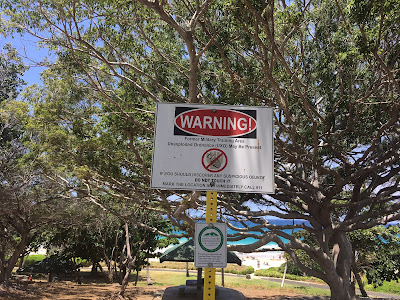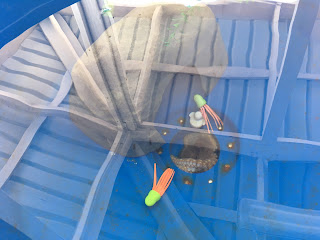Besides aloha, the most commonly used Hawaiian word we heard was “mahalo”.
Alex pointed out that we only ever saw it in vaguely passive-aggressive contexts, and thus it made sense to think of it as meaning “fuck you”:
Please do not smoke in the rental car. Mahalo.
This area of the parking lot is reserved for valet parking. Mahalo.
Please remain seated until the captain has turned off the fasten seatbelts sign. Mahalo.
As busy managerial types whose entire lives consist of prioritizing things, Alex and I figured it would make sense to rank The Top 10 14 Things you should do on the Big Island of Hawaii.
- Snorkeling with the Manta Rays - this is legitimately super cool and requires basically no skill whatsoever other than putting on a wet suit. (Yes, you can fail to put on a wet suit properly. For example, if you put your foot through the arm sleeves. It’s really hard to get out of when you do that, too. Don’t ask. Alex still has scabs from it.) We went with Jack’s Diving Locker, and they were great.
- Sitting on the beach in a cabana drinking fruity tropical beverages - it turns out there’s a great reason why people do this, and the addition of 4G dramatically enhances the experience
- Visiting the summit of Mauna Kea - we did the tour with Arnott’s Lodge & Hiking Adventures, and if you are lucky enough to get our guide, Dave, you will be in for a treat; can’t say what happens if you’re on the tour with the grumpy Australians who hate children. Plus, sky show!
- The Kona Octopus Farm - seriously, who would miss this actually, unlike almost every use of the word, unique experience
- Hiking Kilauea Iki - totally worth the suffering.
- Staying at Volcano Rainforest Retreat - such wonderfully well made housing.
- Seeing the volcano in Volcano National Park - lava! Real lava! OMG.
- Snorkeling near the hotel. Or snorkeling somewhere else, if you are staying in a different hotel.
- Ocean Rider Seahorse Farm - they are adorable. Plus you can learn about seahorse tea.
- The Hawaiian Vanilla Company — Alex whined so much about going here (“you want us to pull over and turn around to do what?”), but it was great. Try to show up in time for lunch.
- Eating shave ice - no, it’s not as good as you expect it to be. Also, getting 3 flavors results in a weird brown flavor after 10 minutes. Still, it’s cheap so you should do it.
- Hilo Tropical Botanical Garden - because who doesn’t love orchids?
- Mackenzie State Park - so much erosion!
- Kehena Black Sand beach - mostly because of the lady who sold us cobbler. If you see her, tell her hi!
Things that weren’t really worth it:
- Going on a lava boat tour when there isn't very much lava flowing into the ocean - unless you enjoy being seasick
- Place of Refuge - So boring that we forgot to include it in the original list of things that aren't worth doing. I hear it's better if you go when the rangers are actually there and giving talks.
- Snorkeling in Kealakekua Bay - unless you enjoy sunburn and seeing the same fish you saw at the resort, made better by a 30 minute boat trip
- Chain of Craters road - yes, it’s cool to see the old road that got covered in lava, but most of the craters are honestly kinda boring
- Coffee Farm - snooze. Possibly less snoozeworthy if you enjoy coffee.
- Most of the food. Geez. (Especially from a vegetarian perspective.)
- Akaka State Park - it has a waterfall. Who doesn’t, these days? Literally the only thing you can do at this park is walk 5 minutes to the waterfall, photograph it, and then walk back to your car.
- Going to Hapuna State Park. Comparing it to the beach near our hotel:
Swimmable? No No
Cabanas? Yes No
Fruity drinks? Yes No
Unexploded ordnance? No Yes
The winner is pretty clear.
Anyway, that's the last post about our trip Hawaii (or I guess the first one, if you just came to our blog). Look forward to more updates to the blog in another 3 years or so! Mahalo!















